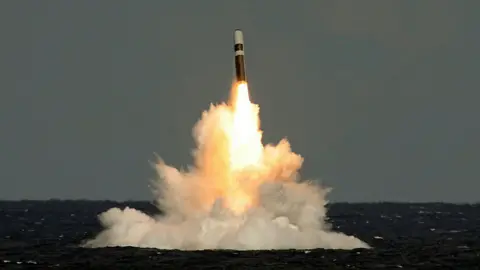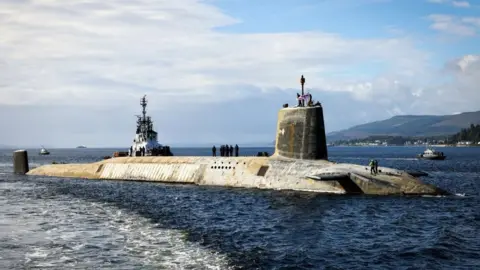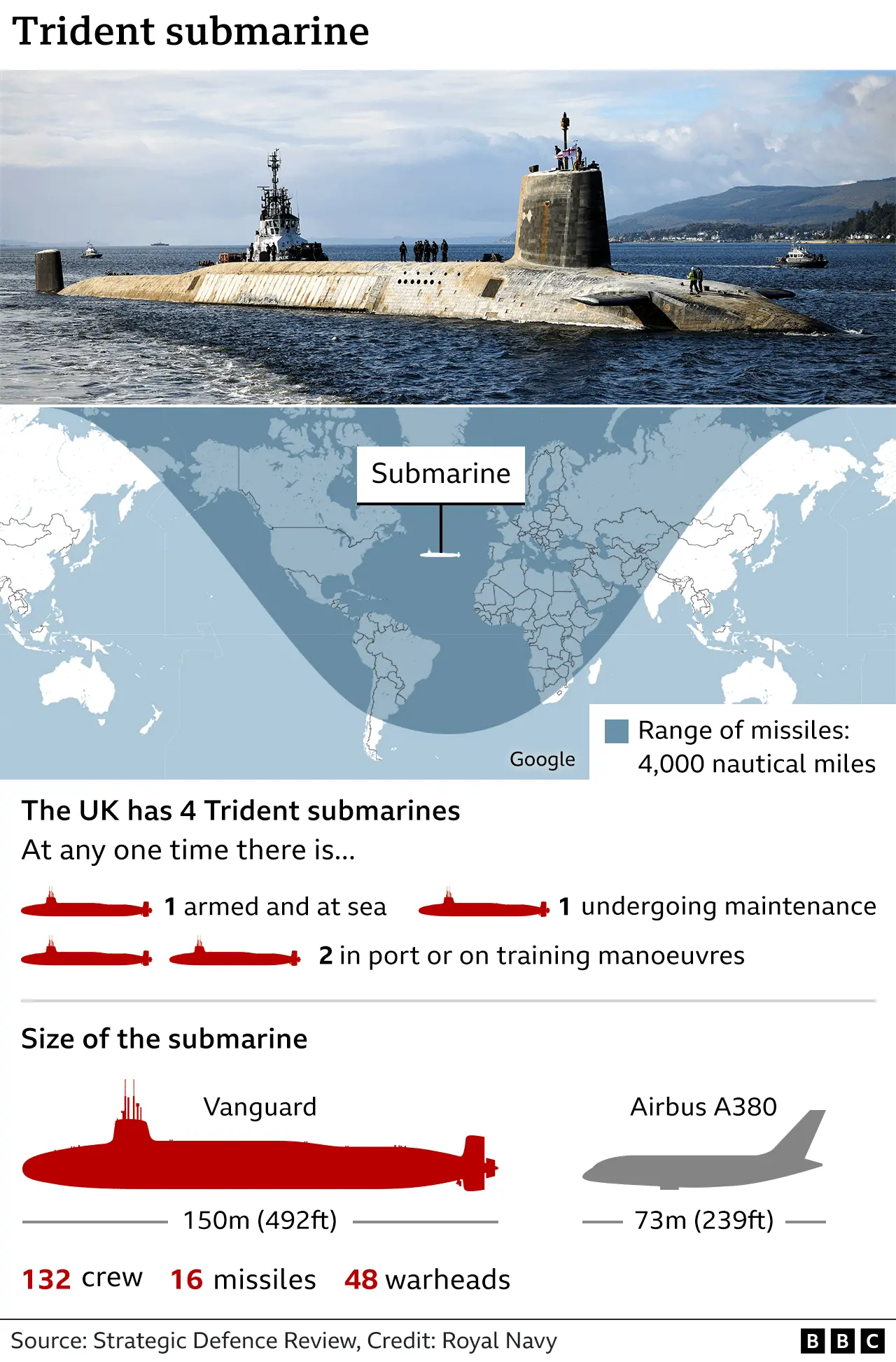Trident missile test fails for second time in a row
 UK Ministry of Defence / Crown copyright
UK Ministry of Defence / Crown copyrightThe test firing of a Trident missile from a Royal Navy submarine has failed, for the second time in a row.
The latest test of the UK's nuclear deterrent was from HMS Vanguard and was seen by Defence Secretary Grant Shapps.
The missile's booster rockets failed and it landed in the sea close to the launch site, according to the Sun, which first reported the malfunction.
Mr Shapps said he has "absolute confidence" in Trident's submarines, missiles and nuclear warheads.
This is highly embarrassing for both the UK and the US manufacturer of the Trident missile.
British tests of Trident missiles are rare, not least because of the cost. Each missile is worth around £17m and the last test in 2016 also ended in failure when the missile veered off course. Test-fired missiles are not armed with their nuclear warheads.
Both Mr Shapps and the head of the Navy were on board HMS Vanguard when it fired the unarmed test missile in January.
The submarine had just had a more than seven-year refit.
In a written statement to Parliament, Mr Shapps confirmed "an anomaly did occur" during the test on 30 January this year, but said Trident was "the most reliable weapons system in the world".
He said: "The test reaffirmed the effectiveness of the UK's nuclear deterrent, in which the government has absolute confidence. The submarine and crew were successfully certified and will rejoin the operational cycle as planned.
"On this occasion, an anomaly did occur, but it was event specific and there are no implications for the reliability of the wider Trident missile systems and stockpiles.
"Nor are there any implications for our ability to fire our nuclear weapons, should the circumstances arise in which we need to do so."
He added Trident remained "effective, dependable, and formidable."
The missile was supposed to have flown several thousand miles before landing harmlessly in the Atlantic between Brazil and West Africa. Instead, it dropped into the ocean near to where it was launched.
At the time of the failed 2016 test, the Sunday Times reported that it was launched from HMS Vengeance off the coast of Florida.
The paper said the Trident II D5 missile was intended to be fired 3,700 miles (5,954 km) to a sea target off the west coast of Africa but veered towards the US.
The cause of what went wrong remains top secret, the paper reported, but quoted a senior naval source as saying the missile suffered an in-flight malfunction after launching out of the water.
Dr Matthew Harries, director of proliferation and nuclear policy at the Royal United Services Institute (Rusi), said it was impossible to say how significant the test failure was.
He told BBC News: "There could be a variety of explanations for something going wrong in what HMS Vanguard was doing in test-launching this missile, and there isn't enough information on what exactly that was.
"The missiles the UK uses are drawn from a common pool that the US and UK both use, and the US has conducted multiple tests without these kind of problems.
"Of course it is embarrassing when the launch is announced in advance and the defence secretary is on board. It doesn't look good."

What questions do you have about Trident?
- Send your questions to [email protected]
- WhatsApp us at +44 7756 165803
- Tweet us @BBC_HaveYourSay
- Please read our terms & conditions and privacy policy

 ROYAL NAVY
ROYAL NAVYThe Labour Party has called for assurances over the effectiveness of the nuclear deterrent.
Shadow Defence Secretary John Healey said: "Reports of a Trident test failure are concerning.
"The defence secretary will want to reassure Parliament that this test has no impact on the effectiveness of the UK's deterrent operations."
The Scottish National Party said spending on "weapons of mass destruction" came at the expense of tackling inequality and conventional military capabilities.
Martin Docherty-Hughes MP, the SNP's defence spokesperson in the Commons, said: "This is the second failed test in a row of weapons that are costing us tens of billions - an embarrassing and scandalous fact that should serve as a wake-up call to the UK government."
The Campaign for Nuclear Disarmament (CND) described it as an expensive failure following a reported £500m refit.
"We need to stop wasting our money on this," said the group, which campaigns to get rid of nuclear weapons globally and in Britain.
In a statement, the Ministry of Defence admitted an anomaly had occurred in the most recent launch.
But it also said that HMS Vanguard and its crew had been "proven fully capable" in their operations and the test had "reaffirmed the effectiveness of the UK's nuclear deterrent".
The statement added that Trident was the "most reliable weapons system in the world" having completed more than 190 successful tests.
The last successful unarmed Trident missile test was in 2012, the MoD confirmed.
HMS Vanguard is one of four of the Vanguard-class nuclear submarines that have been on patrol since 1994, with one of the vessels continually at sea.
The submarines are based at Faslane Royal Navy base on the Firth of Clyde and carry US-built Trident II D5 missiles, while the nuclear warheads are stored at the nearby Coulport armaments depot on Loch Long.
Annual running costs are estimated at 6% of the defence budget - around £3bn for 2023/24, according to the House of Commons Library.
The V-class is due to be replaced by the bigger Dreadnought-class submarines in the 2030s.
Between £31bn and £41bn has been put aside for the wider programme of replacing the Vanguard-class submarines, the House of Commons Library said.

